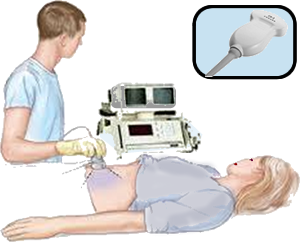 In an obstetric scan the probe used is usually one that looks like a curved soap bar (more accurately known as a 'convex-array' transducer, and the one with a flat surface a 'linear-array' transducer ) which can be slid over the maternal abdomen while maintaining good surface contact to the abdominal surface for the whole width of the probe. It has no moving parts. It is comparatively inexpensive and can be used by relatively unskilled operators. In an obstetric scan the probe used is usually one that looks like a curved soap bar (more accurately known as a 'convex-array' transducer, and the one with a flat surface a 'linear-array' transducer ) which can be slid over the maternal abdomen while maintaining good surface contact to the abdominal surface for the whole width of the probe. It has no moving parts. It is comparatively inexpensive and can be used by relatively unskilled operators.
A frequency of between 1-3 MHz is suitable for abdominal imaging as low frequency waves produce low resolution imaging and increasing attenuation occurs at very high frequency.
Pregnancy problems can be detected and general progress quantitatively monitored by using A-scans for accurate measurements and B-scans for general development.
 A B-Scan produces a sectional 2-D image. Each point on the monitor represents echo amplitude by 'grey-scale' representation. The brighter the point on the screen the 'louder' the echo. This is used to identify the part of the foetus to be measured. A multiple array of transducers is used to gain the information that builds up into the 2-d representation, whereas an A-scan probe only needs a single transducer. A B-Scan produces a sectional 2-D image. Each point on the monitor represents echo amplitude by 'grey-scale' representation. The brighter the point on the screen the 'louder' the echo. This is used to identify the part of the foetus to be measured. A multiple array of transducers is used to gain the information that builds up into the 2-d representation, whereas an A-scan probe only needs a single transducer.
|